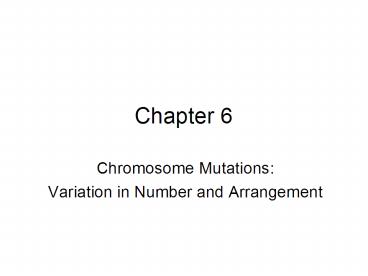Chromosome Mutations: - PowerPoint PPT Presentation
1 / 17
Title:
Chromosome Mutations:
Description:
Down Syndrome ... Maternal Age and Down Syndrome. Extra 21 may be from mom or dad but 95 ... Familial Down Syndrome caused by a translocation of chromosome 21 ... – PowerPoint PPT presentation
Number of Views:281
Avg rating:3.0/5.0
Title: Chromosome Mutations:
1
Chapter 6
- Chromosome Mutations
- Variation in Number and Arrangement
2
Modification at Chromosome Level
- Modifications to the DNA structure is not only at
the gene level - Deviation from the normal 2n diploid number of
chromosomes - Modifications can be change in number, deletion
or duplication of genes or segments of
chromosomes, rearrangement of the genetic
material either within or among chromosomes - chromosome mutation or chromosome aberrations
- pass on to offspring in a predictable manner
unique genetic outcome
3
Terminology
- Aneuploidy organism gains or looses one or more
chromosomes but not a complete set - Monosomy loose a single chromosome
- Trisomy gain of a single chromosome
- Euploidy complete haploid set of chromosomes
are present - Polyploidy more that 2 sets are present
- Triploid 3 sets tetraploid - 4 sets etc.
4
(No Transcript)
5
Variation in Number
- Caused by non-disjunction
- Paired homologs fail to disjoin during
segregation results in non-disjunction - Occurs during meiosis I or meiosis II
- if in meiosis I then 2 cells with 2 copies of the
chromosome and 2 cells without that chromosome - if in meiosis II then only 1 cell with 2 copies
of the chromosome, 1 without that chromosome and
2 normal cells - results in trisomy or monosomy
6
(No Transcript)
7
Monosomy 2n-1
- May have severe phenotypic effects
- Usually monosomy of autosomal chromosomes is not
well tolerated - In Drosophila
- see missing chromosome IV
- slow to develop, reduced body size and impaired
variability - monosomy of II or III must be lethal as none have
ever been recovered
8
Aneuploidy
- Usually 1 copy of the gene is sufficient but if
that gene is recessive lethal, then the organism
may die - Aneuploidy better tolerated in plants
- maize, tobacco, evening primrose and jimson weed
- usually less viable than diploid derivatives
- monosomic pollen grains rarely viable
9
Segmental Deletion
- Rarely see autosomal monosomy after birth,
usually dont survive embryonic/fetal
development - Survivors with partial monosomy part of the
chromosome is missing segmental deletion
10
Cri-du-chat Syndrome
- Missing part of short arm of chromosome 5 46,5p
(all chromosomes but a piece of p arm of 5) - Anatomical malformations, gastrointestinal and
cardiac complications, mental retardation, also
glottis and larynx is abnormal so the cry like a
meowing cat - 1 in 50,000 births, usually a sporadic event
during gamete formation - larger the deletion of p arm more dramatic
effect on child - p arm contains the TERT gene which is telomerase
transcriptase that maintains the telomeres
during DNA replication
11
(No Transcript)
12
Trisomy
- Addition of a chromosome to the diploid number
- Usually a parallel monosomy individual is more
viable especially if it is a small chromosome - Large autosome trisomy is usually lethat in
animals and Drosophila - Trisomic plants are viable but phenotype may be
altered - usually grow slower, depends on which chromosome
is in triplicate
13
Down Syndrome
- Only human autosomal trisomy that survive past
1st birthday 3 copies of chromosome 21
47,21, 1 in 800 live births - Have very characteristic facial, hand and finger
features, psychmotor and mental development is
slow - Prone to respiratory disease and heart
malformation, increased incidence in leukemia - Usually display a subset of phenotypic
characteristics
14
(No Transcript)
15
Down Syndrome Critical Region
- May be a critical region on chromosome 21 that
is dosage sensitive with in 3 copies, responsible
for many of the phenotypes seen Down syndrome
critical region - Made a mouse with 3 21s but didnt display
characteristics of syndrome
16
Maternal Age and Down Syndrome
- Extra 21 may be from mom or dad but 95 are
maternal - 1 in 1000 at 30 years old
- 1 in 100 at 40 years old
- 1 in 50 at 45 years old
- 50 of affected births is in women old
- Not sure if the age of the ovum is the issue or
not - Genetic counseling in older women may recommend
amniocentesis or chorionic villus sampling look
at karyotype of child
17
Inheritance of Down Syndrome
- Not thought to an inheritable disorder but it
does tend to run in families - Familial Down Syndrome caused by a translocation
of chromosome 21 - different cause of the aberrant chromosomes































